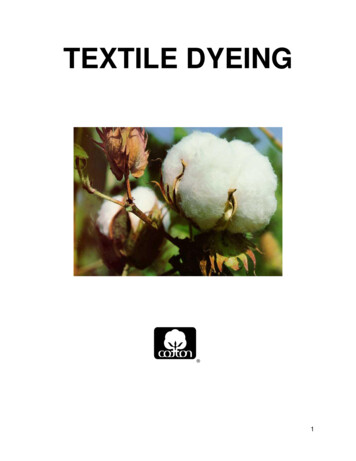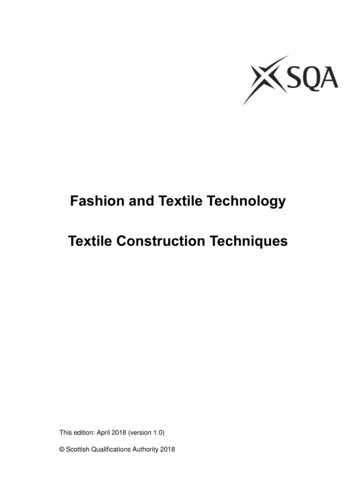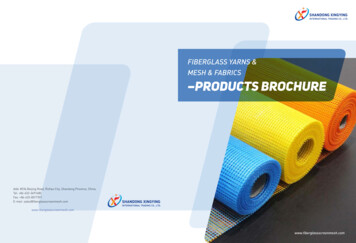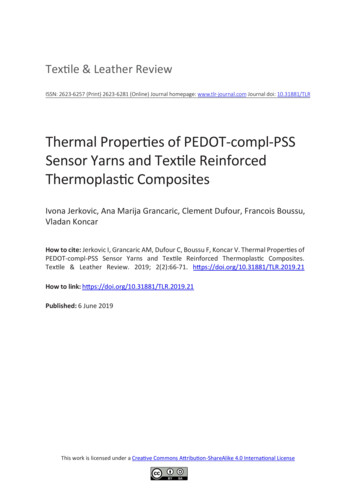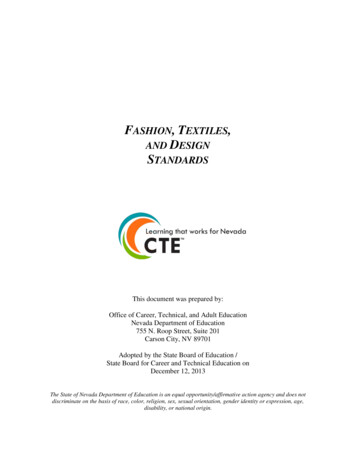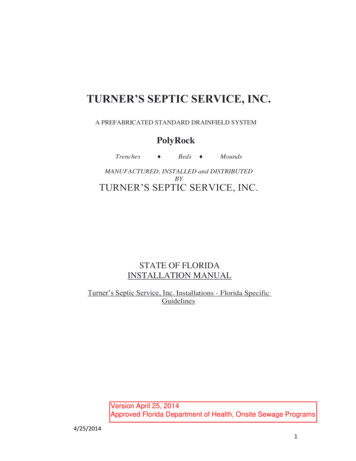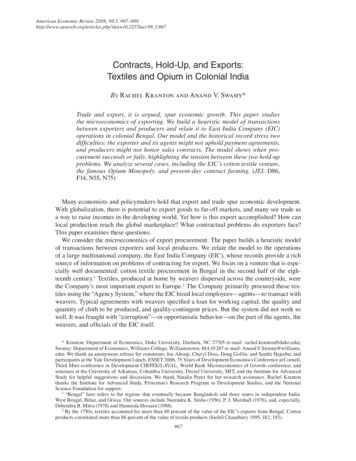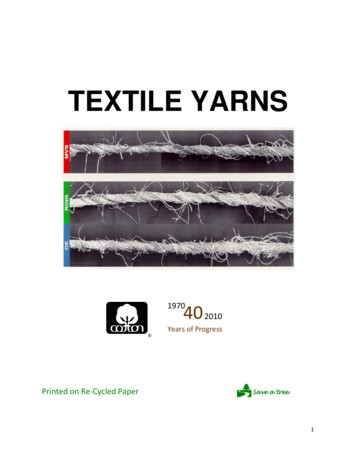
Transcription
TEXTILE YARNS197040 2010Years of Progress Printed on Re-Cycled Paper Save a tree.1
Textile Yarns1.0 IntroductionA textile yarn is a continuous strand of staple or filament fibers arranged in a formsuitable for weaving, knitting, or other form of fabric assembly. Also, a yarn is a textileproduct of substantial length and relatively small cross-section consisting of fibers withtwist and/or filaments without twist. The yarn can be twisted with one or more yarns tocreate added value or aesthetics. Traditionally, yarns have been constructed of fibersof finite length called staple fibers. Today, continuous filament yarns are also usedto construct yarns.Filament yarns tend to be smoother, more lustrous, more uniform, harsher, and lessabsorbent. Spun yarns have a hairy surface, are more uneven in appearance, havelower luster, are softer, and more absorbent. Spun yarn is the yarn of choice in manywoven and knitted fabric products. The short fibers can be natural fibers such as cottonwhere the fiber grows in short lengths. But they can also be synthetic fibers such aspolyester that are manufactured in a continuous length and then cut into shorter staplelengths.This document will discuss how yarns are formed. It covers fiber preparation andspinning for cotton and blends of cotton. Also covered is the production of syntheticfilaments and their conversion to tow and how the tow in turn gets cut into short fibers.Then the steps in the processing of cotton and cotton/synthetic blended spun yarns andthe various spinning systems used will be addressed. Emphasis will be placed upon theinfluence of the yarn on fabric properties and performance.2.0 Fibers for Staple Spinning ProcessesNatural fibers (with the exception of silk) are classified as staple fibers because theirlength can be measured and is typically less than 10 inches (25.4 cm). Cellulosic fibersincluding cotton are 2.5 inches (6.35 cm) or less in length and are labeled short staple.The vast majority of cotton fibers are less than 1.5 inches (3.8 cm). Animal hair fiberssuch as wool, cashmere, mohair, and others are less than 10 inches and are referred toas long staple. Regardless of source, staple fibers are considered ready for spinningwhen received at the textile spinning plant.Manmade filament yarns are converted to staple fibers in order to spin on the shortstaple or English spinning system. Filament yarns have a limited number of filamentsthat are extruded from a spinnerette device as shown in Figure 1. The spinnerette islike a shower head, it contains a certain number of small holes which allow continuous2
filament fibers to be extruded. Left in this form the yarn is classified as a flat filamentyarn. Plastic chips are shown here as the raw material for the manufacturing of thesefilaments.Figure 1 - Filament Extrusion Through a Spinnerette.Filament yarns can be textured as shown in Figure 2. Texturizing allows for betterwicking, less luster, more stretch, more bulk, and a softer feel. To manufacture syntheticshort fibers to be used in spun yarns, filaments from many extrusion heads arecombined into a single strand called tow. The formed tow, containing several millionfilaments, is crimped to create good fiber-to-fiber cohesion and is then cut into shortlengths of fiber for use in spun yarns. The cut fibers are blended prior to baling. At theyarn manufacturing plant, numerous bales are used in a lay-down to further blend outvariation.3
Figure 2 - Textured Filament Yarn.3.0 Staple Spinning Systems3.1 Ring Spun YarnsThe processing of a cotton ring spun yarn must go through a carding machine. If it isdesired, the fiber may also be combed which would be in addition to the carding. Acarded cotton ring spun yarn begins with a bale lay-down. Figure 3 shows the flowof cotton staple fiber from the bale laydown through ring spinning. There are multiplebales in the lay-downs (see Figure 4). A lay-down is a grouping of bales of fiber basedon fiber properties to meet the specifications of a particular yarn. Each lay-down feedsinto a series of opening and cleaning equipment. Bales are then placed in an individuallay-down according to fiber strength, fiber length, fiber micronaire (thickness of thecotton fiber), and color. Cotton from different growth regions may be in different laydowns or in the same lay-down. A lay-down of cotton fibers would be in a separate areafrom a lay-down of another fiber type such as polyester.Small tufts of fibers are plucked from the bales by a top-feeder which automaticallymoves up and down the lay-down. The bales are normally computer selected so thatlay-downs are controlled according to important properties of the fibers assuringconsistency from lay-down to lay-down.The fiber tufts are then processed through various types of opening and cleaningmachinery in order to open or separate the fibers which also aids in cleaning or removalof trash particles mixed in with the fiber. The trash is composed of cotton plant materialssuch as leaf trash and seed hull fragments.4
Figure 3 – Carded Ring Spun Yarn Processing RouteFigure 4 – Multiple LaydownsCoarse opening equipment is used to open larger fiber tufts and remove larger trashparticles followed by fine openers to open smaller tufts and remove smaller trashparticles (See Figures 5 and 6). Good opening and cleaning will enhance improved5
carding which is the next process. Careful attention is given not to overwork the cottonfibers which would lead to fiber breakage and weak and uneven yarn. Improper openingleads to poor cleaning and uneven product formed at the carding process. Most openingand cleaning equipment utilizes wire-covered rollers to progressively open and cleanthe cotton fibers. Waste removed during the opening process will normally be recycledto capture any lost fiber while extracted plant waste may be used to supplement cattlefeed or be used as an energy alternative such as incineration for energy.Figure 5 – Coarse Cleaner.Figure 6 – Fine Opener.The fibers are moved via duct work to a multi-cell blender which is used to create amore uniform blend of cotton fibers. They can also be used to further blend differentfiber types together. A multi-cell blender can be seen in Figure 7.6
Intimate blending of cotton fibers with other fiber types can be done using a series ofmachines that weigh different amounts of each fiber and then drop the fiber onto aconveyor belt (see Figure 8). A rotating beater at the end of the conveyor belt will mixthe fibers together. Additional blending of the fibers is done on other equipment such asmulti-cell blenders. This intimate blend of fibers is especially helpful when dealing withdyed fabrics with a potential for shade variation and other dyeing problems.Figure 7 – Multi-cell Blender.It is now time for the opened, cleaned, and blended fibers to go through the cardingprocess. The carding machine shown in Figure 8 has a chute feed which delivers a thickmat or blanket of fibers to rotating wire-covered cylinders that separate individual fibersto create total fiber opening. Most small particles of trash that are left in the fibers andneps (small entanglements of fibers) will get removed at carding. The card wires willform a thin layer of fibers which looks like a spider web. The action of the cardingsurfaces helps to align the fibers. The card web gets condensed at the front or deliveryend of the carding machine to form what is called a sliver. The strand of sliver will beplaced into a large cylindrical can and transported to the next process (see Figure 9). Itmust be remembered that all fibers are carded whether cotton or cotton blends,including fibers that go into combed yarns.7
Figure 8 – Intimate Blending – Fiber BlendingBlendersFigure 9 - Carding Machine Delivering Sliver.8
Carded sliver is then transported to the drawing process where multiple cans of sliverare placed behind the drawing machine. The multiple ends of sliver are fedsimultaneously through a set of progressively faster rotating rollers which aids in betterfiber alignment and improved blending (see Figure 10). A 100% cotton blend wouldhave all slivers of cotton.If desired, slivers of different fiber type can be blended at drawing to produce a fiberblend referred to as a draw blend. In Figure 10, if three cotton slivers were blended withthree polyester slivers, the result would be a 50/50 cotton/polyester blend in thedelivered sliver. Draw blends are used when shade variation in dyeing will not be ascritical and also when forming a fiber blend for heather yarns. Sliver blending is moreproductive than fiber blending.Figure 10 – Drawing for Fiber Blending.When processing combed ring spun yarns, some additional processes must beincluded (see Figure 11). After card slivers go through one drawing step, lap winderswind multiple ends of sliver in a parallel arrangement onto a spool or package called acomber lap. Laps are in turn placed onto the combing machines. Combing is a valueadded process and will make various improvements to the sliver quality. It removesshort fibers, neps, and any remaining small trash particles while parallelizing the fibers.Thus the resulting yarn will contain longer fibers, fewer neps, and be cleaner. Improvedfiber alignment will lead to more uniform yarns. Combed fibers are mainly used in ring9
spun yarns. Combing allows the spinning of finer counts of yarn that cannot be spunwith just carded fiber.Figure 11 – Combed Ring Spun Yarn Processing Route.Shown in Figure 12 is a comber lap containing 24 carded and drawn slivers that is fedat each position on the comber. A typical comber has eight positions, each oneproducing a sliver. One single combed sliver will ultimately be delivered from each lineof comber heads from the combing machine, and will later be blended with combedslivers from other machines.When sourcing combed yarns, one must be aware of the different qualities. Qualities ofcombed yarns will vary according to the percentage noil (waste removed) and whetheror not the yarn is fully or only partially combed. A fully combed yarn will be producedwhen all slivers making up the yarn have been combed. Partially combed yarns areproduced from a mixture of combed and carded slivers. When evaluating combed yarnsbased upon noil removed, one must be aware of the quality of the incoming fiber.Percentage noil removed may range from as low as 4% to as high as 24%. Based on aconsistent input quality, 16% noil removal would produce a better quality combed yarnthan 10% noil removal.Since combed yarns contain longer fibers, less twist can be added for comparablestrength and thus the yarn and resultant fabric will be softer. Less yarn twist also leadsto less yarn and fabric skew or torque. Combed yarns are more even in diameter and10
size with lower tendency to pill and shed fibers. Normally one or two additional drawingprocesses will follow combing to help improve combed sliver evenness or uniformity.Figure 12 – Comber Lap With 24-Drawn Slivers.The following chart summarizes the differences between carded and combed yarns.Carded and Combed Ring Spun Yarn ComparisonCardedCombedShorterLongerLess evenEvenNepsMoreLessTrashMoreLessFiber otherThickerThinnerLusterLessMoreProcessing CostsLessMoreStaple LengthEvennessStrengthRange of countsYarn surfaceDiameter11
Whether making carded ring spun yarn or combed ring spun yarn, the next step will bethe production of roving. Roving is a strand of fibers lightly twisted together with athickness similar to a pencil or pen. Drawn slivers are fed into the machine and bobbinsof roving are delivered. Roving is the product that is fed into the ring spinning machinethat follows the roving process. In Figure 13, a drawing of a typical roving machineshows the drafting rollers that control the roving thickness. The rotation of the flyer andbobbin inserts a low level of twist into the roving, just enough to hold the rovingtogether.Figure 13 – Typical Roving Machine.In ring spinning, roving is fed through a series of rotating rollers which draft or reducethe roving thickness into the final yarn thickness which equates to the yarn count or yarnnumber (see Figure 14). By adjusting the differential speed of the drafting rollers toreduce the linear mass, a range of yarn counts can be produced from the same roving.The reduced mass of fibers is passed through a traveler which rotates around astationary ring device. At the same time the bobbin of wound yarn is also rotating(slightly higher rate than the traveler). The rotation of traveler and bobbin allows thenecessary yarn twist to be inserted. The rotational direction of the ring bobbin can beclockwise or counterclockwise to produce Z and S twist yarns (explained later). Thetwist will migrate from the traveler up to the nip of the front roller. Since the spinningbobbin rotational speed is constant, the front drafting roller is slowed down to allowmore twist insertion and speeded up to allow less twist insertion. Finer yarns require12
more twist and therefore the production is lower while coarser yarns require less twistwhich promotes a higher productivity. That is why finer yarns tend to cost morecompared to coarser yarns.Figure 14 – Ring Spinning.Looking at the magnified picture of a ring spun yarn in Figure 15, it is evident that thefibers form a very regular orientation. The natural unevenness of the yarn is created bythe variable lengths of fibers going through the drafting rollers on the ring spinningmachine. Shorter fibers get trapped between the rollers, forming thick and thin areas inthe yarn. Ring spun yarns have higher strength and have a softer hand (feel) comparedto the other spun yarn types. The higher cost associated with ring spun yarns is due tolower productivity, more processes involved, and more personnel needed.Compact ring spun yarns are formed when an extra set of rollers are placed in front ofthe original delivery roller. These rollers create pressure and have a perforated screenthrough which air suction is applied to keep the fibers tight around the yarn axis and tolay the fiber ends into the yarn surface, making the yarn smoother, stronger, more even,and less hairy. Therefore pilling is reduced which can be a savings in downstreamprocessing. Figure 16 shows a conventional ring spun yarn being formed on the left13
and a compact spun yarn being formed on the right. Notice the higher levels ofhairiness on the conventional ring spun yarn.Figure 15 – Longitudinal View of Ring Spun Yarn.Figure 16 – Comparison of Conventional Ring Spun to Compact Ring Spun.14
Once ring spun yarn is formed onto the small ring bobbins, the bobbins must bedelivered to a separate winding operation where a number of yarn bobbins will beconsecutively unwound and their yarn transferred to a much bigger yarn cone or tube.At winding the yarn can be “cleared” which means that imperfections can beelectronically detected and automatically removed right before the yarn is placed on thepackage. Also a disk of wax can be located just before package winding in order tolubricate the yarn surface. Wax is applied mainly to knitting yarns in order to reduceyarn surface friction which allows more constant yarn tension and less needle abrasion,and a more consistent product.3.2 Open End Spun YarnOpen end spun yarn (sometimes called rotor spun yarn) is produced with fewerprocesses as seen in Figure 17 and more automation compared to ring spinning.Therefore it is less labor intensive. The productivity is generally 8-10 times highercompared to ring spinning. Because no roving is necessary for open end spinning,typically single-processed or double-processed drawing sliver is fed into the machine.No separate winding operation is needed in open end spinning since the yarn packagesare formed on the machine as the yarn is delivered from the rotor. Also, open end spunyarns offer better evenness and less skew than ring spun and air jet yarns.Figure 17 – Open End Spinning MachineThe fibers are mostly parallel in the open end yarn core but are more randomlyarranged on the yarn surface. There is also the presence of wrapper fibers which tendto be perpendicular to the yarn axis. The wrapper fibers are like a belt around the waistof the yarn. These wrapper fibers are very unique to open end yarn and make it easy toidentify microscopically. Wrapper fibers do not contribute to the yarn strength; therefore,the yarn is generally 15 to 20 per cent weaker than ring spun yarn. The wrapper fibers15
also create a harsher hand than found in ring spun yarn. Figure 18 shows a longitudinalview of the wrapper fibers and fiber orientation of an open end yarn. However, openend spun yarns are more uniform and exhibit less torque than ring spun.Figure 18 – Longitudinal View of an Open End YarnWrapper fiberThe rate of feeding the sliver into the open end rotor controls the yarn count or size ofthe yarn produced (see Figure 19). Thus different counts of yarn can be produced fromthe same size sliver by adjusting the speed of the feed roll. The combing roll has a wirecovered surface to aid in separating the fibers from the sliver and introducing them to atapered channel for transport to the rotor. The rotation of the rotor stays constant whilea delivery roller controls the rate of yarn delivery from the rotor. A slower delivery allowsthe rotor to turn more times which puts more twist in the yarn. A higher delivery speedwould do the opposite. As in ring spinning, finer yarns need more twist and coarseryarns need less twist. After the yarn is formed, it travels through the navel which islocated in the center of the rotor. The navel can be easily changed to produce a more orless hairy yarn which affects the hand of the yarn and resulting fabric. Navels can havehigh frictional surfaces or be smoother to enable the processing of different yarncharacteristics. The rotors in open end spinning turn in a clockwise direction only andthus only Z twist can be inserted.16
Figure 19 – Schematic of Open End Spinning Box.4DoffTubeSliver3.3 Air Jet YarnThere are two types of air jet spinning technologies. These are MJS (Murata JetSpinning) and MVS (Murata Vortex Spinning).3.3.1 Conventional Air Jet Spinning (MJS)Conventional air jet spinning is referred to as the MJS (Murata Jet Spinning) systemsince Muratec, a Japanese company, is the only supplier of the technology. As shown inFigure 20, air jet spinning also does not use the roving process and does not need aseparate winding operation. The productivity is 20 to 22 times higher than ring spinningand approximately twice that of open end spinning. Air jet spinning has automationsimilar to open end spinning. Conventional air jet spinning is restricted to the use of100% manmade fibers and blends of cotton and manmade fibers. Yarns containing100% cotton are too weak for normal end uses.Air jet yarns have a parallel core of fibers which are held together by a narrow band orribbon of fibers that are spirally wrapped around the yarn surface. The tightness of thewrapping of the ribbon fibers is controlled by an air nozzle. Tighter wrapping leads tostronger but stiffer yarn. These yarns have a reputation of producing less pilling infabrics. Figure 21 shows MJS air jet nozzle N1 and N2.17
Figure 20 – Air Jet Yarn Processing Route.Figure 21 – MJS Air Jet Nozzle.18
3.3.2 Vortex Spun Yarns (MVS)The newest method of air jet spinning is known as vortex spinning or MVS. A vortexof highly rotating air flow is created by multiple air nozzles to form a yarn that has similarproperties as ring spun yarn. This system of spinning is capable of producing 100%cotton yarns and cotton /synthetic blends compared to MJS. MVS imparts better fiberorientation thereby allowing 100% cotton to be used. Figure 22 shows the fibers flowinto the vortex area and flare out prior to moving through a narrow channel. The flaredfibers form the outer spiral wrap of fibers that get twisted around the yarn core fibers,creating a ring-like hairiness. Any short fibers in the fiber mix will be vacuumed awayand end up as spinning waste. The waste will be recycled into another form of yarn.Figure 22 – MVS Air Jet Nozzle4.0 Summary of Short Staple Yarn Characteristics4.1 Longitudinal ViewWhen comparing the microscopic views of the different yarn types, the similaritybetween the ring spun and vortex (MVS) yarns is evident. Figure 23 shows longitudinalviews of MVS, ring, and open-end yarns.19
Figure 23 – Longitudinal Views of Different Short Staple Yarns.4.2 Comparison of Properties of Different Spinning SystemsThe following chart illustrates the differences in ring, open end, MJS air jet, and MVSvortex spun yarns. The upper part of the chart lists advantages of each type of yarn andthe lower part of the chart lists disadvantages of each type. Ring spun and open endyarns dominate in apparel fabrics today with air jet and vortex yarns playing a muchsmaller role. Lighter weight fabrics, referred to at times as top weight fabrics, willtypically contain ring spun yarn since open end yarn has a lower spinning limit (coarsercounts formed). Air jet yarn is used in a lot of sheeting fabrics and shirting. Open endyarn is used in underwear, socks, denim, sweaters, and other outerwear garments.Sometimes it is desirable to have a more uneven look in fabrics (homespun look) andfor that reason ring spun yarn is chosen.With respect to the count ranges that can be spun on the different systems, ring spunhas the widest range of sizes. Ring spun frames can make yarns from a 1/1 Ne up towell over 100/1 Ne with long staple fibers. Open end systems can spin yarnseconomically from 1/1 to 40/1 Ne. The finer counts require combing in order to spinwithout defect and weakness. Air jet spinning can produce yarns from 20/1 Ne to 80/1Ne.20
Comparison of Properties of Different Spinning SystemsRing SpunOpen EndMJS – Air JetMVS – VortexAdvantagesAdvantagesAdvantagesAdvantages1. Strongestyarn1. More even1. Very highproductivity1. More ring-like2. Finest yarn3. Softest yarn4. S and Z twist2. High strengthuniformity3. Higherproduction rate4. Fewerprocesses5. Lower costs2. Lower hairiness2. Fewerprocesses3. Dyes darker3. Good evenness4. Good hand4. Less pilling5. Highestproductivity5. Fewerimperfections6. Fewerimperfections6. S and Z antages5. Lowestproductivity7. Harsher hand6. Weaker yarn6. Lower elongation8. Not as strong7. Limited countrange7. More torque6. Most uneven7. Mostexpensive8. More hairygenerally9. Limited countrange10. More abrasive11. Z twist only8. Harsher andstiffer hand8. More waste inspinning9. Z twist only10. Limited countrange9. More torque5.0 Twist in Spun YarnsTwist is necessary in spun yarns in order for the yarn to have adequate strength for agiven end use. However, added twist will make the yarn harsher, stiffer, and have moretorque. The following is a list of yarn properties affected by twist: diameter or fineness,contraction, softness/hand, torque or liveliness, bending behavior, absorbency, covering21
power, permeability, tensile strength, stretch and recovery, crease resistance, abrasionresistance, pilling behavior, and luster.The amount of twist in a spun yarn is described as turns per inch (tpi). There are twodirections of twist, Z and S. As mentioned previously, Z and S twist yarns can be formedin ring spinning but only Z twist in open end spinning. Air jet yarns do not have a trueconventional twist; however, MJS machines are offered in both Z and S fiber wrapdirections. Figure 24 gives a drawing of “Z” and “S” twist of fibers in a yarn.Figure 24 – Comparison of Z and S twist of Fibers in Yarns.Twist direction becomes important in twill designed woven fabrics. Any time the twilldirection in the fabric is opposite from the twist direction in the yarn, the twill line will beraised more on the fabric surface. Twist direction is also important in plied yarns whichare discussed later in this document. Skewness in knitted fabrics is related to yarn twistdirection and machine rotational direction. Twist direction opposite from the rotationaldirection of the knitting machine tends to produce fabrics with less torque or skew.Alternating Z and S twisted yarns supplied to the knitting needles can reduce fabrictorque or skew. However the appearance for some fabrics may be negatively affectedsince every other knitting course will have knit loops slanting in opposite directions.22
6.0 Yarn NumberingSpun yarns and filament yarns are assigned a number to represent their respectivethicknesses. Yarn count, yarn number, and yarn size are terms related to thethickness of a yarn. Overall, there are two types of numbering systems, indirect anddirect. In the indirect numbering system, it is important to remember that the bigger theyarn number, the finer the yarn, but in the direct numbering system, the bigger the yarnnumber, the coarser the yarn. Spun yarns are typically numbered using the indirectsystem and filament yarns are typically numbered using the direct system. Figure 25gives a graphic image of the difference between direct and indirect yarn numbering.Figure 25 – Comparison of Indirect and Direct Yarn Numbering.English cotton count (Ne) is an indirect numbering system along with metric count(Nm) and worsted count (Nw). All yarn numbers represent the linear density of theyarn and really describe a ratio of length to weight or weight to length. A Ne 20/1 yarnmeans that twenty 840 yard lengths of yarn weighs one pound. This would equate to16,800 yards of yarn per pound of yarn. On the other hand a Ne 10/1 yarn means thatonly ten 840 yard lengths of yarn weigh one pound. Thus the Ne 10/1 yarn is coarserthan the Ne 20/1 yarn. A Nm 20/1 yarn means that 20 kilometers of yarn weighs onekilogram. A Nm 10/1 yarn means that only 10 kilometers of yarn weighs one kilogram.Nw 20/1 yarn means that twenty 560 yard lengths of yarn weighs one pound. Nw 10/1yarn means that ten 560 yard lengths of yarn weigh one pound. Yarn numbers are an23
important bit of information on fabric specification sheets. The yarn size will affect fabriccharacteristics such as weight, thickness, stiffness, luster, appearance, and hand.Denier is a direct numbering system along with tex and decitex. A 150 denier yarnmeans that it takes 150 grams of yarn to measure a standard length of 9000 meters.Thus a 200 denier yarn requires 200 grams of weight to measure 9000 meters. So theyarn number is simply the number of grams of yarn in a standard yarn length of 9000meters. A 20 tex yarn means that a standard yarn length of 1000 meters weighs 20grams and a 200 decitex yarn means that a standard length of 10,000 meters of yarnweighs 200 grams. So these yarn numbers are simply the weight of yarn in gramsequating to different standard lengths of measure.Many times it may be necessary to convert one yarn number into another yarn numberin order to understand its relative size or for consistency. Some common conversionfactors are listed below.Ne 5315/DenierNe 2/3 NwDenier 5315/NeDenier 0.9 x DecitexNe 590.6/TexNe Nm/1.693A yarn numbering conversion chart is found in the Appendix.7.0 Plied YarnsPlied spun yarns are numbered so that the number of plies can be indicated along withthe count of each individual yarn making up the plied yarn. For example, a 36/2designation would represent two 36 single yarns (36/1) plied together. Sometimes thenumber of plies is written first and then the single yarn number such as 2/36.Technically speaking this is a designation for a worsted or long staple yarn. Generally,the twist direction of the single yarns is opposite from the ply twist direction in order toreduce yarn torque and fabric skew. Plied yarns will be stronger and can be made withless stiffness compared to a single yarn equivalent. The extra step of plying adds someadditional cost to plied yarns. Most sewing threads are plied or cabled. Plying alsoimproves yarn uniformity. The term “doubles” should not be confused with plied yarns.Doubles is when two yarns are fed to a fabrication method parallel to each other. Thiscan be done on a knitting machine or loom and are not plied together. Thus, in thefabric, they will randomly cross over one another. Plied filament yarns have a differentdesignation. For example, the 2/150/34 designation means that two 150 denier yarnsare plied together and each contains 34 filaments. Figure 26 shows twisting of fibersinto a singles yarn, twisting of singles yarns to a ply, and twisting of plied yarns into acord or cabled yarn.24
Figure 26 – Yarn Assembly By The Use of Twist.Plied YarnsNe 40/1StapleNe 40/1Cord orCabled YarnNe 40/2Ne 40/2/2FibSingles8.0 Special Effect Yarns8.1 Slub YarnsNovelty or fancy yarns have special effects placed into the yarn strand and give aunique look to fabrics. The effect may be slubs of various lengths and thicknesses. Forexample, engineered denim fabrics have this novelty look. A leading supplier ofequipment for making slub yarns is Amsler and some refer to these yarns as Amsleryarns. Figure 27 shows a yarn board showing yarns with slubs of various lengths anddiameters. These can be formed in a random manner to prevent patterning.Figure 27 – Slub Yarn.25
Simple and complex slub yarns can be formed today. In fact, you can design aparticular slub pattern and download it into the spinning machine. Technology is alsoavailable to simulate how the yarn slub pattern will look in the resultant fabric.8.2 Core YarnsCore yarns are those made that have a core of one type of fiber or configuration and anouter core of the same or another type fiber and configuration.8.2.1 Core Spun YarnsCore yarns have multiple components. A yarn is placed in the core and other fibers oryarns are placed around it. A very common core yarn is called corespun. This yarn hasa core yarn which can be a spun or filament yarn and
blend referred to as a draw blend. In Figure 10, if three cotton slivers were blended with three polyester slivers, the result would be a 50/50 cotton/polyester blend in the delivered sliver. Draw blends are used when shade variation in dyeing will not be as critical and also when forming a fiber blend for heather yarns. Sliver blending is more
